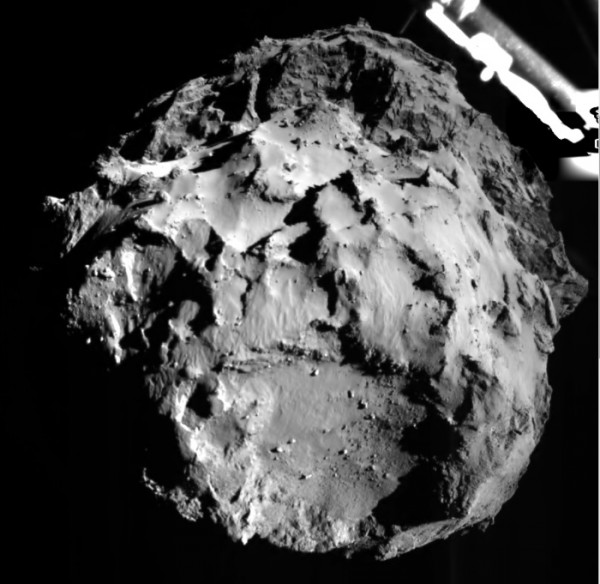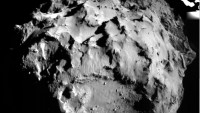Time and Energy Running out for Philae Lander
| Nyrene Paranga | | Nov 14, 2014 07:49 AM EST |
(Photo : ESA/Rosetta/Philae/ROLIS/DLR) Comet 67P/CG as seen from the Philae lander during descent on Nov 12, 2014 14:38:41 UT from 3 km from the surface.
(Photo : weather.com) Philae Lander on Comet 67P
ESA's Philae lander bounced twice after landing and finally came to rest about a kilometer away from its target spot on Comet 67P/Churyumov-Gerasimenko.
Philae's current location only allows few hours of illumination from sunlight. If this continues, the lander's batteries might soon run out of power.
Like Us on Facebook
The Philae robotic probe is a lander from the European Space Agency. It landed on Comet 67P/Churyumov-Gerasimenko, which is circling the sun, last November 12.
The goal of the Rosetta mission is successfully attach Philae to the comet and acquire information about the comet's composition.
The robot probe is currently in the shadow of a cliff. The probe needs sufficient sunlight to recharge its batteries using its solar panels.
In its current state, it only receives one and a half hours of illumination instead of the required seven hours. Moving the lander to spot with more light will be a very risky move.
Conducting heavier activities like hopping or drilling will only consume more power. The lander's primary will last for about 60 hours. After that, the probe will hibernate.
At present, the lander team is focusing on acquiring information without consuming too much power. This is a strategy intended to preserve more battery power for the rest of the mission.
The lander team established a stable signal and successfully received pictures of the comet surface. The mission has yet to obtain samples of materials from the comet surface for analysis.
If no further action regarding the power supply is taken, the lander's batteries are expected to completely run out by Saturday.
Whether the mission can access a more stable power supply is yet to be confirmed.
Whatever happens next, Philae and its team have already made a perfect landing in the history books.
This mission could answer some of our biggest questions about the Solar System and the universe. Yet the chances of discovering these answers are stuck under a cliff buried in the shadows.
Tagsphilae lander, rosetta, european space agency, comet 67P, solar system, Space
©2015 Chinatopix All rights reserved. Do not reproduce without permission
EDITOR'S PICKS
-

Did the Trump administration just announce plans for a trade war with ‘hostile’ China and Russia?
-

US Senate passes Taiwan travel bill slammed by China
-

As Yan Sihong’s family grieves, here are other Chinese students who went missing abroad. Some have never been found
-

Beijing blasts Western critics who ‘smear China’ with the term sharp power
-

China Envoy Seeks to Defuse Tensions With U.S. as a Trade War Brews
-

Singapore's Deputy PM Provides Bitcoin Vote of Confidence Amid China's Blanket Bans
-

China warns investors over risks in overseas virtual currency trading
-

Chinese government most trustworthy: survey
-

Kashima Antlers On Course For Back-To-Back Titles
MOST POPULAR
LATEST NEWS
Zhou Yongkang: China's Former Security Chief Sentenced to Life in Prison

China's former Chief of the Ministry of Public Security, Zhou Yongkang, has been given a life sentence after he was found guilty of abusing his office, bribery and deliberately ... Full Article
TRENDING STORY

China Pork Prices Expected to Stabilize As The Supplies Recover

Elephone P9000 Smartphone is now on Sale on Amazon India

There's a Big Chance Cliffhangers Won't Still Be Resolved When Grey's Anatomy Season 13 Returns

Supreme Court Ruled on Samsung vs Apple Dispute for Patent Infringement

Microsoft Surface Pro 5 Rumors and Release Date: What is the Latest?













